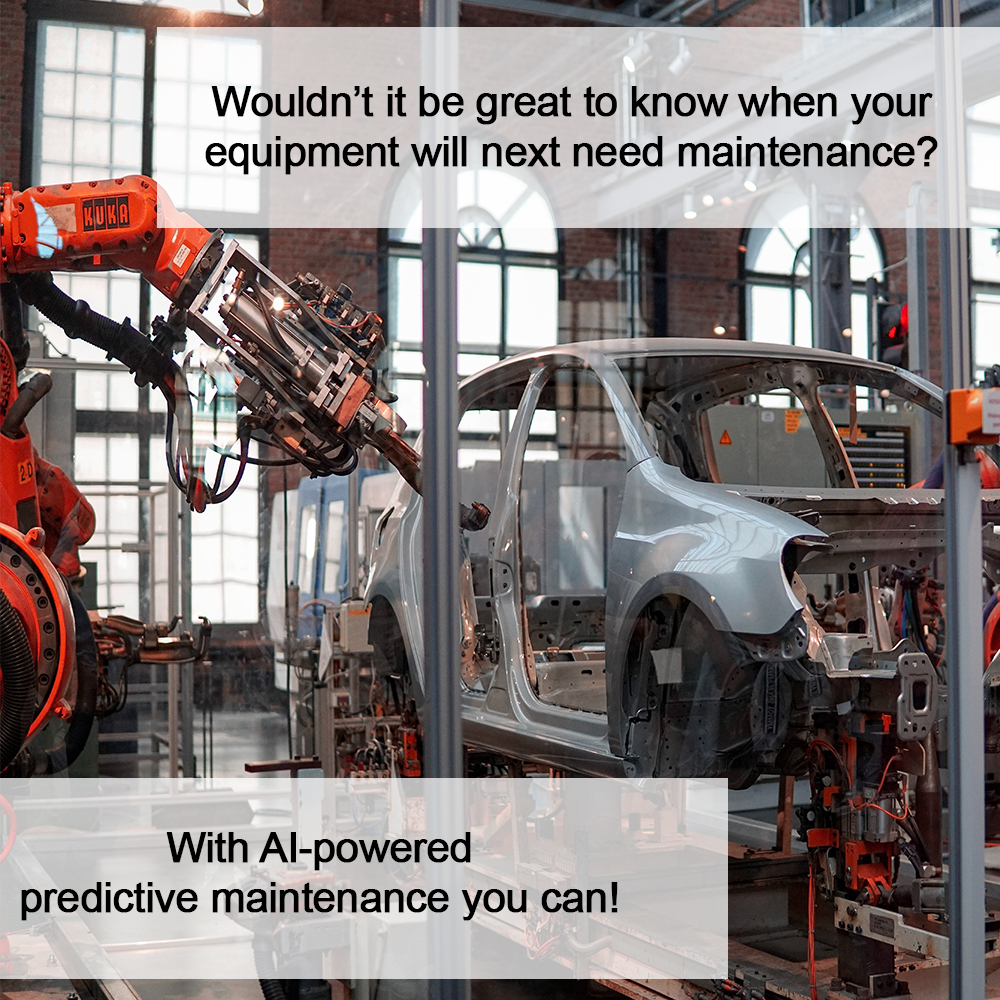Maintaining critical manufacturing equipment isn’t all that different from changing the oil in your car: the manufacturer and your local repair guy tell you to do it every 3,000 miles but your experience tells you that the oil will likely last 6,000 miles – which will save you a decent amount of money over the years. But can you be sure? A jammed piston is a serious problem – just like unplanned line downtime or expensive repair of a piece of critical equipment.
Wouldn’t it be great if somebody – or something – could tell you more accurately when you need to change the oil, replace a piece, tighten a screw, clean a pump, or perform whatever steps are needed to keep your equipment running smoothly?
That technology actually exists: artificial intelligence is a powerful tool that allows manufacturers to proactively identify potential equipment failures, optimize maintenance schedules and with that make your operations more efficient.
This article explores how AI for predictive maintenance is changing manufacturing and why it represents a superior approach to existing methods.
How AI Improves Predictive Maintenance
AI-enabled predictive maintenance is capable of analyzing vast amounts of sensor data, historical records and real-time operational information. By continuously monitoring equipment performance, AI solutions can identify patterns, establish what normal operations look like, detect deviations from that normal patter, then use that information to predict potential failures with remarkable accuracy. This allows manufacturers to proactively address maintenance issues before they lead to costly breakdowns and production interruptions but it also allows them to push out scheduled maintenance and replacement of parts if it isn’t necessary.
To go back to our oil change example: AI could tell you at 4516 miles that you should change the oil in the next 100 or so miles. That information bought you more than 1500 extra miles of driving but prevented the damage that would have happened had you gone with your gut feeling to only change it at 6000 miles.
What Are the Benefits of AI for Predictive Maintenance Applications in Manufacturing
Better forecasting of maintenance using AI has many advantages. Here is a list of the most important ones:
- Improved equipment uptime: AI algorithms can identify early signs of equipment degradation, so maintenance teams can intervene promptly if necessary. But there is a second aspect to this: if the maintenance crews know a specific part needs to be replaced or cleaned soon, they can schedule these repairs or replacements during already planned downtime and maximize equipment uptime.
- Cost Savings: AI for predictive maintenance applications help optimize maintenance schedules which avoids unnecessary scheduled maintenance as well as the often high cost associated with reactive maintenance. Preventing unplanned downtime is a major consideration for many manufacturers, especially if it is associated with costly damage to equipment, spoiled products, or high cost of starting the line up again.
- Enhanced Efficiency: the insights AI systems generate based by crunching vast amounts of data allow manufacturers to prioritize critical maintenance tasks and deploy maintenance crews where they are needed the most. Optimized workflows, reduced maintenance backlog and increased overall operational efficiency are the consequence.
- Increased Safety: Unexpected breakdowns can be (very) costly as well as dangerous for the workers on the shopfloor. Fewer unexpected breakdowns reduce the risk of accidents and make the working environment safer for employees.
- Codifying Knowledge: It’s surprising to see how often maintenance in the 21st century is still based on experience of long-time employees. The fact that the equipment “didn’t sound right” or “vibrated too much” are great reasons to perform maintenance. But what if that experienced employee retires or changes jobs? AI systems learn to detect these patterns from sensor data (e.g., sensors recording sound volume and frequency or vibrations) thereby codifying that critical knowledge.
AI for Predictive Maintenance – A Good Place to Start
There is a lot of hype about AI out there, a lot of talk about “paradigm shifts”, “technological revolutions”, “harnessing the power of AI” and other phrases right out of the consultants’ playbook. The reality is that AI will indeed change how manufacturers operate as its advantages are simply too real and too large to ignore. The question is not “Will a manufacturer adopt AI?” but “When will they adopt AI?”
The prospect of bringing AI in house might be daunting but as it is unavoidable it makes sense to start sooner rather than later – and predictive maintenance is a great place to start. Picking one piece of equipment that causes frequent issues or even one that doesn’t but where data has been collected over a long period of time (months to years) allows you to ease into AI adoption and deployment. A proof-of-concept study can show the value but also get your shopfloor and maintenance staff comfortable with the advantages of AI and build trust in the solutions.
“The quality control staff at one of our customers was initially very doubtful about AI, didn’t trust the results, and often double-checked just to be sure.
Now, a year later, when a defect is reported the first question is ‘What does the AI model say?’
Our AI models had to earn their trust and, based on their performance, they passed with flying colors.”
Uli Palli, CEO Accella AI
If you are ready to start the process of adopting AI for prediction maintenance applications for your manufacturing plants, we are here to help you and happy to have an informal chat about how to do it. Contact us here.
If you would like examples of how AI can help your company perform QC, you can read our article on The Role of AI Models in Visual Inspection.
By: Tina Baumgartner, VP of Business Development, Accella AI


